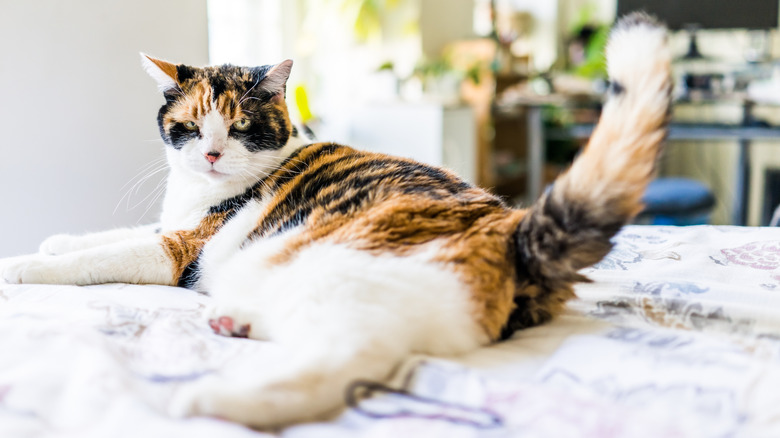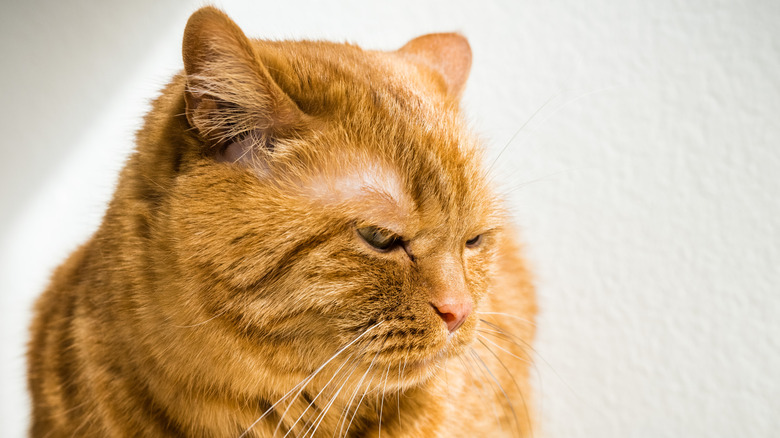Don't Ignore These Subtle Body Language Cues When Petting Your Cat
Being a cat parent can be quite the adventure when you consider the many odd and comical behaviors of these small whiskered predators. They don't bark like their canine counterparts, but cats still make their feelings known in their own less-obvious way, especially when they're agitated. If you don't want to upset your feline friend, it's best not to ignore these subtle body language cues, particularly while petting it. They include tail thrashing and certain ear and head movements.
Of course, you shouldn't ignore the obvious signs of irritation either, unless you're fine with entering the danger zone. For example, your cat might hiss or growl, swat at your hands, or even bite or scratch you. You also shouldn't wait until these behaviors occur before you reevaluate how you're petting your cat. If you make it a habit to ignore your cat's comfort wishes, it might start to keep its distance from you or run and hide every time you approach it.
Many cats relish receiving and showing affection, but that doesn't mean they want it every time their humans want to give it. It also doesn't mean you'll get their royal approval for any new petting techniques you decide to try. For example, your kitty might love a good chin scratch, but if you randomly go rogue and aim for the tail one day, you could be in for a rude awakening.
A rapid tail thrashing often reveals a cat's aggravation
Cats communicate with their tails (yes, cats wag their tails, too), exposing their emotions through movements that aren't always easy to discern. When a cat is in a good mood as it walks, the tip of the tail typically points upward toward the ceiling, sometimes with a little curve at the end. This is a common tail position for a cat as it approaches its owner to rub against their legs. A candy cane shape (tail pointed upward in the middle and downward at the tip) also indicates a happy cat.
On the other hand, when you notice quick movements of the tail, such as rapid thrashing or thumping, while petting your cat, it usually indicates the opposite emotion. These tail movements are your cat's way of telling you to back off or stop whatever it is you're doing. It might not be in the mood for petting at that moment or just isn't a fan of the body location or your technique. If you ignore your cat's warnings, expect defensive behaviors, some of which could leave you injured from claws or teeth.
Cats use their ears and heads to indicate their agitation
The flicks and thrashes of a tail aren't the only components of a feline's secret language. Cats use their ears and heads, too, to send messages. Think back to the last time your cat enjoyed having you pet it. It might have closed its eyes and purred loudly in satisfaction. The ears were probably facing forward in a neutral position. But, if those loving strokes ever become unwelcome, the ears might tilt back a bit or swivel sideways. Your cat might also flatten its ears against its head. With these behaviors, your cat is basically saying, "I'm not okay with this. Please stop touching me."
These ear movements are often accompanied by head movements, as Dr. Lauren Finka, a cat behavior expert from Nottingham Trent University, pointed out in an interview with BBC Science Focus. "When annoyed, cats might very sharply turn their head towards our hands. Or they may turn their heads to look at us." She added that you might also notice its head shaking.
Learning how to interpret your cat's body language and responding appropriately during petting sessions benefits both you and your pet as well as your relationship. When in doubt, try this: stop the petting for a couple of seconds. If your cat rubs its head against your hand, take it as a sign that you've found a sweet spot. If not, it doesn't necessarily mean you should stop, but always pay close attention to the tail, ears, and head to gauge your cat's response to your touch.


